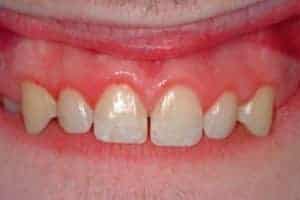Sensitive teeth can quickly ruin a person’s day, yet the problem is incredibly common. The Academy of General Dentistry reports that 40 million people experience tooth sensitivity in the U.S. alone. And when teeth are sensitive, it is never a fun time.
For example, while eating ice cream should be an enjoyable experience, people with sensitive teeth can’t handle foods that are overly cold. Likewise, hot tea can cause a person to suck breath as the pain becomes too intense. Why do teeth become sensitive, and is there anything that can be done to give a person much needed relief?
Causes of Sensitive Teeth
To comprehend the phenomenon of sensitive teeth (otherwise known as hypersensitivity) it is important to understand the anatomy of teeth and how the various parts can become affected by bacteria and other outside elements.
Understanding Hypersensitivity: The Anatomy of a Tooth
The bulk of a tooth is comprised of a material called dentin. Inside the dentin are microscopic nerve endings. In a healthy tooth, the solid outer layer of the tooth (called the enamel) keeps the dentin protected.
When the enamel gets worn away over time, by the foods we eat, by habits such as teeth grinding (bruxism) and the acidic beverages we drink, the nerve endings in the dentin become exposed and hypersensitivity results.
The above is only a partial list of what can actually cause tooth sensitivity. Other causes include:
- Excessive or rough tooth brushing using a hard-bristled brush.
- Tooth decay, faulty fillings, and broken teeth that expose the tooth’s dentin.
- Gum recession that exposes the tooth roots.
- A bite that overloads a tooth, causing an inflamed nerve inside the tooth.
- Tooth flexion from bite issues that cause notches in the necks of teeth called abfractions (non-carious cervical lesions)
- Post-treatment sensitivity. While common, this type of sensitivity is only temporary, and usually follows procedures like crowns, teeth whitening, and fillings.
How to Find Relief from Sensitive Teeth
Dr. Brusky recommends that patients schedule an appointment to visit their dentist right away when tooth sensitivity hits. If the causes are unknown, for instance if no teeth are broken and there aren’t any leaky fillings, then the causes may be invisible. That means that only a dentist using state-of-the-art dentistry techniques and technology can properly diagnose the problem to start the patient on the road to relief.
“For less severe cases, fixing a cavity, replacing a worn out filling, or applying bonding resin and fluoride varnish might be all that’s required,” said Dr. Brusky. “However, for more extreme cases of tooth sensitivity, such as those involving gum recession and root exposure, a tissue graft by a periodontist might be the best course of action.”
Dr. Brusky warned patients not to ignore the pain. “It’s not enough to merely avoid ice cream and hot coffee,” Dr. Brusky said. “The pain is a signal telling your nervous system that something is wrong. By scheduling an appointment with your dentist, relief can be right around the corner.”
To help patients find relief, Dr. Brusky is using a new product that he calls a dentistry game changer. The liquid s called silver diamine fluoride, which is used, in part, for tooth desensitization.
A New Dental Treatment for Instant Pain Relief
Silver diamine fluoride (SDF) is a colorless liquid primarily used for the treatment of hypersensitivity, but the solution has also been used to treat cavities in children.
When applied to sensitive teeth, SDF provides instant relief, kills pathogens and more.
Dr. Brusky is also using SDF as a pain-free dental product. For more information about this product, read our article here.
“Tooth sensitivity can make life difficult, but with the right solutions, any person with sensitive teeth can get back to living pain-and-discomfort-free,” said Dr. Brusky.
To learn more about tooth sensitivity and how to find relief with SDF and other treatments, call or visit our office today.






